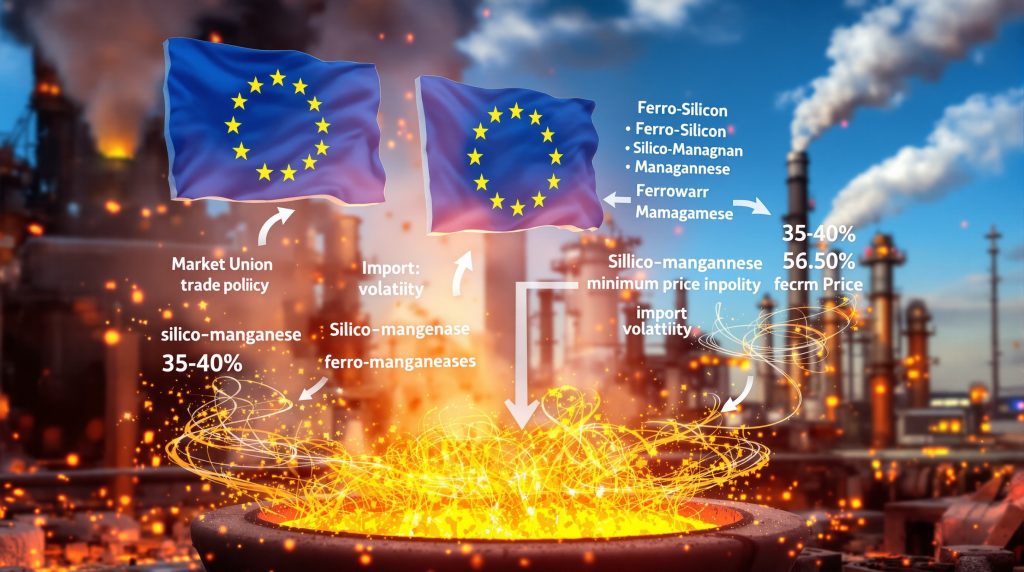Understanding the EU's Minimum Import Price Mechanism for Bulk Alloys
The European Union's ferro-alloys market faces unprecedented regulatory uncertainty as the European Commission considers implementing minimum import prices (MIPs) for key bulk alloy products. This potential trade defense measure has created significant market volatility hedging and strategic challenges for industry participants across the supply chain.
What is driving the EU's consideration of minimum import prices?
Global overcapacity creating market pressure
The ferro-alloys industry currently faces substantial global overcapacity, particularly in ferro-silicon, silico-manganese, and ferro-manganese. This oversupply situation has led to increased imports flowing into the European market at competitive prices, threatening the viability of domestic producers and creating market distortions that European authorities aim to address through targeted trade defense mechanisms.
Market participants have noted that maintaining strategic production capacity within Europe has become increasingly challenging against the backdrop of lower-priced imports, driving regulatory consideration of protective measures.
Split opinions among member states
The European Commission's proposal for minimum import prices has received deeply divided support among EU member states. In a July 2024 advisory vote, eight member states voted in favor while eight opposed the measure, creating an unusual deadlock in the decision-making process.
According to international trade lawyer Arnoud Willems of King & Spalding, this type of split vote situation is unprecedented, noting he had "never seen this kind of situation before" in EU trade defense proceedings. This deadlock significantly complicates the implementation process and leaves market participants uncertain about the final outcome.
For measures to gain final approval, they would require a qualified majority of 55% of member states (15 out of 27) representing at least 65% of the total EU population. Alternatively, a blocking minority of just four member states representing 35% of the population could prevent implementation.
Strategic industrial policy considerations
Beyond immediate market protection, the potential implementation of minimum import prices reflects broader European industrial policy objectives. These include maintaining strategic autonomy in critical materials, ensuring supply chain resilience, and supporting domestic production capacity in sectors deemed essential for European manufacturing competitiveness.
European policymakers increasingly view ferro-alloys as strategic materials necessary for the continent's industrial sovereignty, particularly as these alloys form essential inputs for steel production and other critical manufacturing sectors.
How would minimum import prices affect the EU bulk alloys market?
Potential price increases of 35-40%
According to market analysis, the proposed minimum import prices would increase ferro-alloy prices by approximately 35-40% compared to mid-2024 market levels. This significant price elevation has sparked widespread industry concern about cost implications for downstream consumers, particularly steel market challenges who rely heavily on these alloys as essential inputs.
Industry experts have noted that price increases of this magnitude are "more usual in anti-dumping situations but not for minimum import prices in safeguards," highlighting the unusual approach being considered by European authorities.
Market uncertainty creating price volatility
The ongoing regulatory uncertainty has already triggered significant price volatility as market participants adjust positioning strategies in anticipation of potential changes. Ferro-manganese prices have demonstrated particularly pronounced upward momentum in recent weeks as buyers secure inventory ahead of possible regulatory changes.
The situation has been characterized by Willems as "hanging over the market like the Sword of Damocles," with suppliers and consumers alike struggling to develop effective strategies amid considerable regulatory ambiguity.
Supply chain adaptation strategies
Market participants have developed innovative contractual mechanisms to manage regulatory uncertainty while maintaining commercial relationships. Some suppliers have included specific pricing adjustment clauses that allow transactions at current market levels while retaining rights to adjust final prices should minimum import prices be implemented.
These conditional pricing structures represent an adaptation to unprecedented regulatory uncertainty, allowing business to continue while distributing regulatory risk between parties in novel ways.
What are the three potential scenarios for EU bulk alloys regulation?
Scenario 1: Immediate implementation of provisional measures
The European Commission retains authority to introduce provisional minimum import prices at any time before the investigation concludes. This option would create immediate price effects and market disruption but would provide quick relief to European producers.
However, Willems considers this scenario relatively unlikely given the divided member state opinions expressed in the July advisory vote. The Commission typically seeks broader consensus before implementing provisional measures, particularly when they would create significant market disruption.
Scenario 2: Modified approach with tariff-rate quotas
The Commission could pivot to a tariff-rate quota system similar to existing steel safeguard measures, imposing duties only on imports exceeding specified volume thresholds. This approach would typically require approximately one month for implementation and could represent a compromise position that addresses import concerns while minimizing market disruption.
A tariff-rate quota system would allow normal import volumes to continue at current prices while providing some protection against surge volumes, potentially balancing the interests of domestic producers and downstream consumers more effectively than minimum import prices.
Scenario 3: Recalibration toward definitive measures
The most likely scenario involves continued investigation and stakeholder consultation leading toward definitive measures by the November 19, 2025 deadline. This approach would provide maximum time for market adjustment and policy refinement while maintaining the option to implement comprehensive protection if deemed necessary.
If no definitive measures are implemented by the deadline, the Commission would need to restart the entire investigation process, effectively terminating the current proceedings.
What makes this safeguard investigation unusual?
Minimum prices instead of traditional quotas
The European Commission's consideration of minimum import prices represents a departure from traditional safeguard measures that typically employ tariff-rate quotas. This approach reflects the Commission's assessment that continued imports at existing price levels would not sufficiently support European producers, even with volume restrictions.
According to Willems, the Commission likely shifted course after initial hearings suggested that minimum prices might be more helpful for European producers because "then they could go to a certain profit level and expand production, which is part of the point of the safeguards."
Unprecedented market reaction
The market response to the proposed minimum import prices has been stronger than the Commission anticipated. The substantial gap between proposed minimum prices and current market levels has triggered significant industry pushback and market positioning that may influence the final regulatory approach.
This unexpected market reaction could prompt the Commission to reconsider its approach and potentially adopt less disruptive measures that still address the underlying concerns about import competition.
Challenges with product differentiation
The proposed minimum import price structure faces practical implementation challenges related to product differentiation. Ferro-alloys encompass numerous grades with substantial price variations, creating difficulties in establishing appropriate minimum price thresholds that address unfair competition without disrupting legitimate market segments.
Safeguard investigations typically involve less detailed product analysis than anti-dumping or anti-subsidy investigations, potentially leading to implementation challenges when applied to complex product categories with significant quality and price differentiation.
How does this investigation fit within broader EU trade defense measures?
Existing anti-dumping duties on ferro-silicon
The European Union maintains longstanding anti-dumping duties on ferro-silicon imports from China and Russia. These measures, first introduced in 2008 and subsequently renewed, form part of the comprehensive trade defense framework addressing unfair competition in ferro-alloys markets.
The current safeguard investigation would add an additional layer of protection, potentially addressing import competition from countries not currently subject to anti-dumping measures but still contributing to market pressure on European producers.
Circumvention challenges
Existing trade defense measures face significant challenges from circumvention activities, including falsified origin certificates and transshipment through third countries. European authorities have documented anomalous increases in imports from non-traditional suppliers, suggesting potential circumvention of anti-dumping duties through alternative channels.
The proposed safeguard measures would potentially address these circumvention challenges by applying broadly to imports regardless of origin, closing loopholes that allow circumvention of targeted anti-dumping measures.
Integration with broader steel sector protection
The ferro-alloys safeguard investigation operates within a broader context of European steel sector protection that includes safeguard measures and anti-dumping actions on finished steel products. This comprehensive approach reflects recognition that steel industry competitiveness requires protection at multiple supply chain levels.
Ferro-alloys represent critical inputs to steel production, creating strong interconnections between steel market conditions and ferro-alloy demand and pricing dynamics.
What are the key dates and procedural milestones?
Investigation initiation: December 2024
The European Commission formally launched the safeguard investigation in December 2024, establishing a nine-month investigation period with the possibility of a two-month extension under exceptional circumstances.
This investigation timeline established the framework for collecting market information, holding stakeholder hearings, and developing potential safeguard measures.
Advisory vote: July 2025
Member states participated in an advisory vote regarding the proposed minimum import prices in July 2025, resulting in an even split with eight votes both for and against the measures. While this vote was non-binding, it provides important guidance for the Commission's approach.
The divided opinion expressed in this vote has created unprecedented uncertainty regarding the likely outcome of the investigation and potential implementation of safeguard measures.
Definitive measures deadline: November 19, 2025
The Commission must implement definitive safeguard measures by November 19, 2025, or the investigation will conclude without action. This deadline creates a critical decision point that will determine the future regulatory framework for European ferro-alloys markets.
If no definitive measures are implemented by this deadline, the Commission would need to restart the entire investigation process to pursue any future safeguard measures.
How are market participants responding to the uncertainty?
Innovative contract structures
Suppliers have developed specialized contract structures that incorporate regulatory contingencies, including price adjustment clauses that automatically trigger if minimum import prices are implemented. These innovative arrangements distribute regulatory risk between suppliers and consumers while maintaining transaction volumes during periods of uncertainty.
These contractual innovations represent a market-based solution to unprecedented regulatory uncertainty, allowing business continuity while protecting parties from potential adverse regulatory impacts.
Strategic inventory management
Market participants have adjusted inventory positions in response to regulatory uncertainty, with some buyers increasing stockpiles to hedge against potential price increases while others maintain minimal inventory to limit exposure to potential price decreases if measures are not implemented.
These divergent inventory strategies reflect different assessments of regulatory probability and risk tolerance among market participants, creating additional market complexity and potential volatility.
Differentiated customer strategies
Long-standing customer relationships have provided stability within the uncertain environment, with certain suppliers maintaining stable pricing for established customers while adjusting terms for new or spot market transactions. This differentiated approach reflects the value placed on customer loyalty during periods of market disruption.
Suppliers have focused on transparency and communication with customers, explaining potential regulatory impacts and developing collaborative strategies to manage uncertainty while maintaining supply chain integrity.
What factors will influence the final decision?
European industrial competitiveness
The Commission must balance protection for domestic ferro-alloy producers against potential cost implications for downstream industries, particularly steel manufacturers who rely on these materials as essential inputs. This balancing act requires careful consideration of both immediate economic impacts and longer-term strategic objectives.
Downstream industry groups have expressed significant concerns about potential cost increases and competitive disadvantages that could result from minimum import prices, creating countervailing pressure against producer interests.
International trade obligations
Any implemented measures must comply with World Trade Organization agreements and European Union trade defense regulations, requiring rigorous economic analysis demonstrating both increased imports and resulting injury to domestic producers, along with a causal relationship between these factors.
Safeguard measures face particularly stringent requirements under WTO rules, potentially limiting the Commission's flexibility in designing and implementing protective measures.
Strategic autonomy objectives
European industrial policy increasingly emphasizes strategic autonomy in critical materials and manufacturing capabilities, potentially supporting more robust protection measures despite short-term cost implications for downstream consumers.
The ferro-alloys case represents a test case for balancing immediate market efficiency against longer-term strategic industrial policy objectives, with significant implications for future European trade defense approaches.
What are the broader implications for global trade?
Potential trade diversion effects
Implementation of European minimum import prices could redirect ferro-alloy trade flows toward alternative markets, potentially creating cascading effects as other regions consider their own protective measures in response to increased import pressure.
Global ferro-alloy producers would likely need to reconfigure export strategies and potentially accept lower margins in alternative markets if European access becomes constrained by minimum price requirements.
Precedent for future trade defense approaches
The European Commission's approach to ferro-alloys safeguards could establish important precedents for future trade defense actions, particularly regarding the use of minimum import prices as an alternative to traditional volume-based restrictions.
The unprecedented procedural situation and market reactions may influence how the Commission approaches future safeguard investigations across multiple sectors and product categories.
Supply chain reconfiguration incentives
Sustained implementation of minimum import prices would create incentives for supply chain reconfiguration, potentially encouraging increased domestic production capacity and alternative sourcing strategies that reduce reliance on imports subject to trade defense measures.
Such reconfiguration could create long-term structural changes in European ferro-alloy supply chains, with impacts persisting well beyond the immediate regulatory timeframe.
Navigating market uncertainty in EU bulk alloys
The European ferro-alloys market faces a critical period of regulatory uncertainty as the European Commission evaluates potential safeguard measures, including minimum import prices that could significantly alter market dynamics. Market participants must navigate this uncertainty through strategic positioning, contractual innovation, and careful risk management while preparing for multiple potential regulatory outcomes.
The Commission's final determination, expected by November 2025, will establish the regulatory framework governing European ferro-alloys markets for years to come, with significant implications for domestic producers, international suppliers, and downstream consumers. This decision will balance complex considerations including industrial competitiveness, strategic autonomy objectives, and international trade obligations while addressing the fundamental challenges posed by global overcapacity and increased import penetration.
The unprecedented nature of this investigation – particularly the evenly split advisory vote and consideration of minimum import prices instead of traditional quota-based safeguards – creates unique challenges for both regulators and market participants as they navigate an uncertain path toward resolution. The final outcome will not only shape European ferro-alloy markets but may establish important precedents for future European trade defense approaches across multiple sectors, ultimately impacting US-China trade war impacts and creating new investment opportunities 2025 based on the tariffs impact analysis.
Want to Spot the Next Major Mineral Discovery Before the Market?
Discover why timing is everything when it comes to mineral discoveries with Discovery Alert's proprietary Discovery IQ model, delivering real-time notifications of significant ASX mineral announcements directly to your inbox. Visit our discoveries page to see how early investors in major mineral finds have generated exceptional returns and begin your 30-day free trial today.




